Chinese Carved Ivory
Introduction
Text-to-speech Audio
These emperor and empress figures are hand-carved from elephant tusks. Using special carving tools, the artists were able to duplicate intricate details of the ceremonial clothing and accessories. Since 1989, importing ivory has been outlawed…
Ivory…. the mere word conjures up thoughts of rare and costly beauty. Carved from elephant tusks, ivory's many cultural uses have made it highly prized since pre-historic times. Early carved examples found in Chinese tombs date well before 1000 BCE, and there are fine examples from every subsequent dynasty through the Qing (1644-1912). Like gold, ivory has always epitomized luxury and wealth in China and around the world…
Four examples of standing ivory figures dating to around 1900 are on display. The first pair of unusually large figures is to the left of Mrs. Howard in section four of the Schaffner case. The second pair further to the left in section two is backed by a mirror to allow closer inspection of the reverse sides. All four are exceptional for their finely carved details. They depict Chinese emperors and empresses dressed in Qing imperial attire. Although carved ivory is usually left natural, in various periods in China it has been lacquered or stained with colors such as the black stain on our displayed pieces…
Below the mirrored figures on the second shelf are other examples of carved ivory from the Asian Art Collection, including a finely carved piece showing stairs going up from street life to family life to a scholar's study. On the third shelf is an Imperial Court necklace from the Howard Collection like the one the carved emperor is wearing…
Click on the first picture to begin the slide show…
Images
A Chinese emperor and empress of the Qing dynasty.
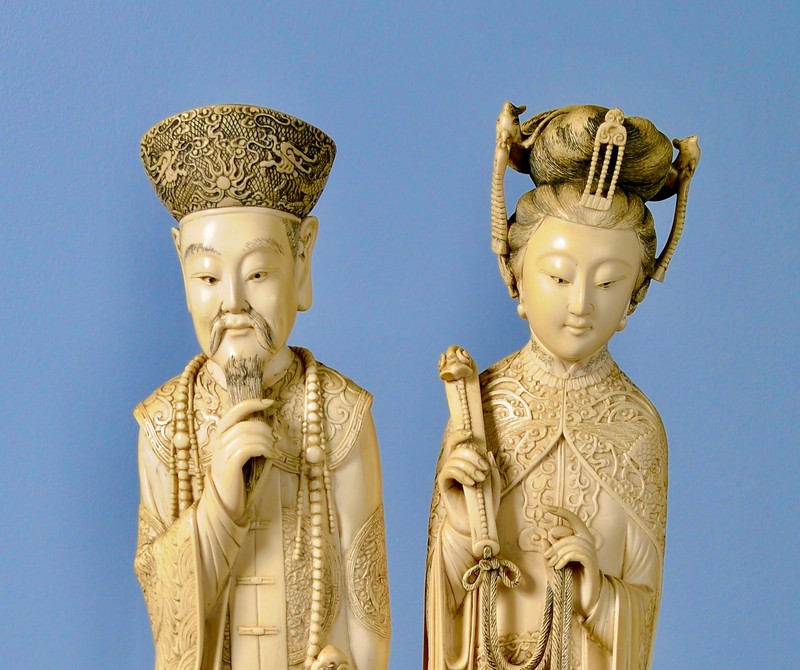
The emperor and empress standing in the traditional position with the male to the right.
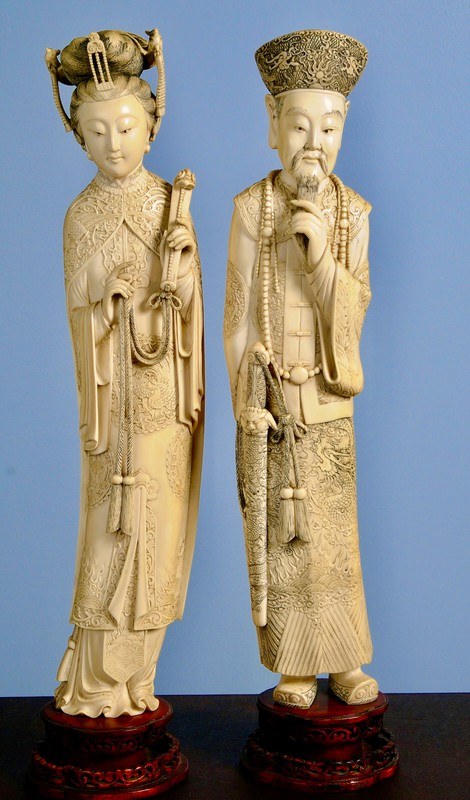
The photo of the backs of the tall royalty figures shows the elaborate carving of his queue and her complicated "high rising coil and swallowtail" hairstyle.
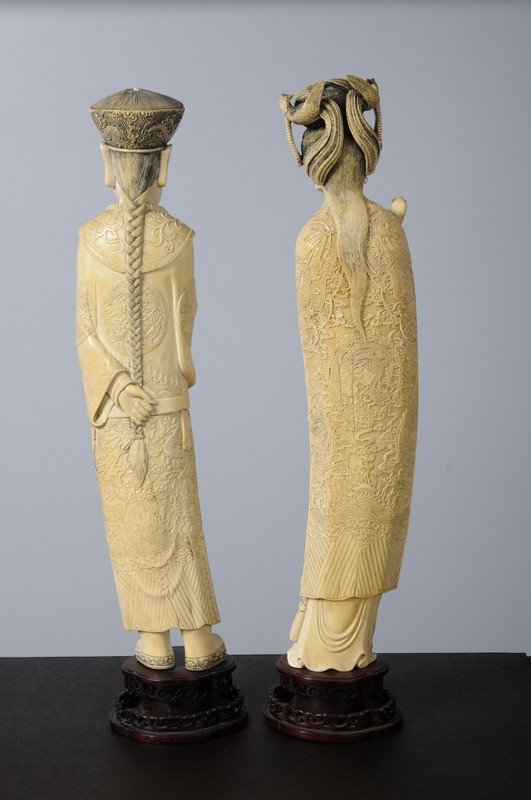
The tall emperor has lost the spike on his hat that should connect him to the heavens.
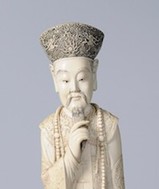
The tall empress contemplates her life of luxury.
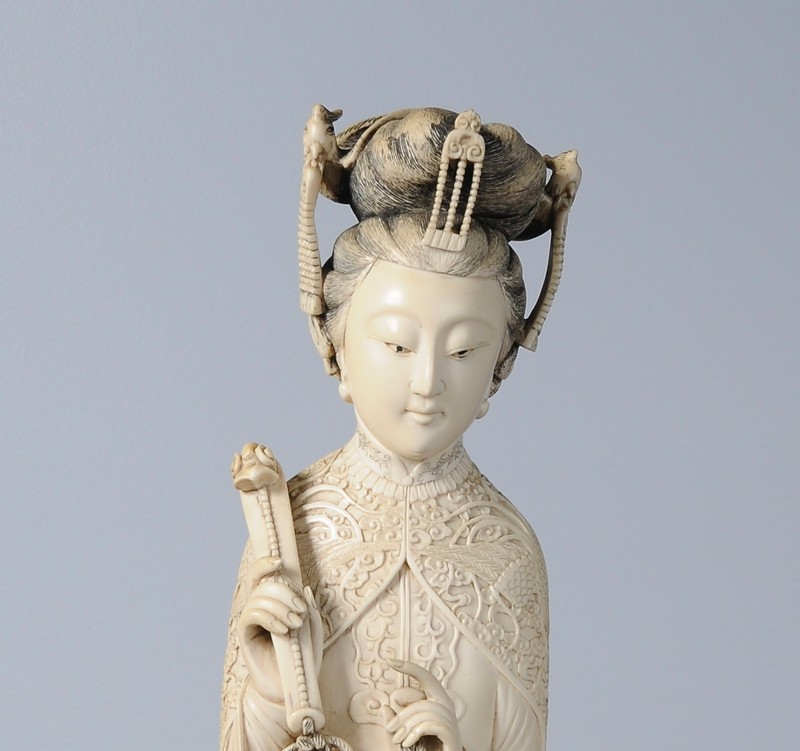
The desire for luxury ivory items has made the elephant an endangered species.
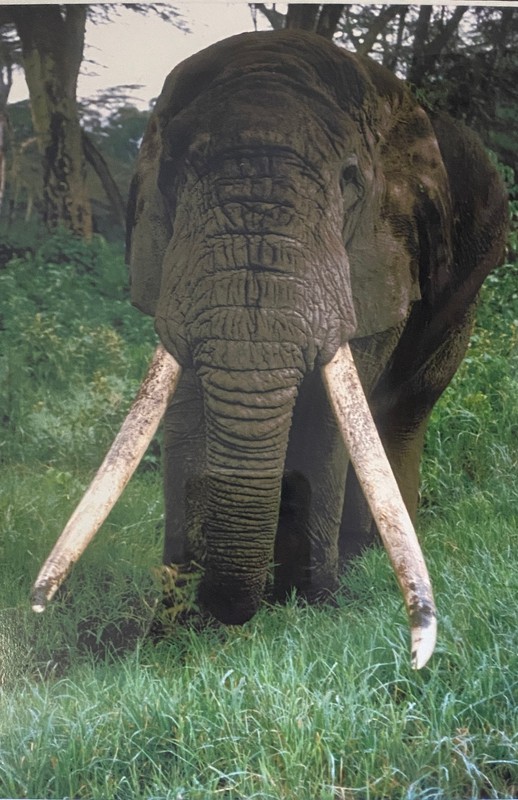
The second pair of carved figures resembles the taller pair, but the spike on the emperor's hat is visible.The spike was believed to connect the emperor to the mythological gods in heaven.
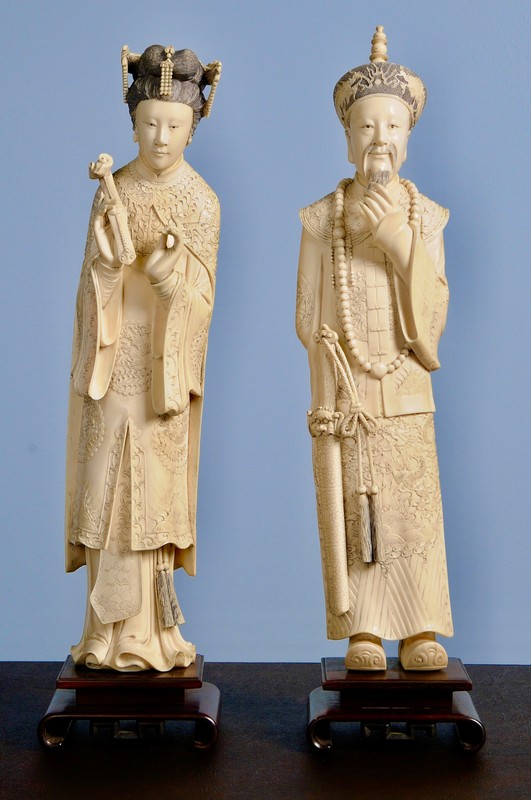
While the emperor also has a queue, the empress has a different, less complex hair style that still features the crown of cranes.
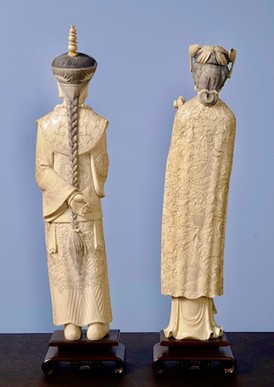
This emperor's queue hides a loose strand of beads that would swing back and forth and was intended to keep the evil spirits away.
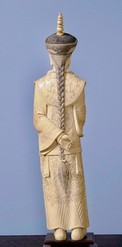
Imperial beads with three short strands and a long strand to ward off evil spirits.

Look closely at the back of the empress' cloak to see a phoenix inside a medallion and the Eight Precious Things of the Taoist Eight Immortals.
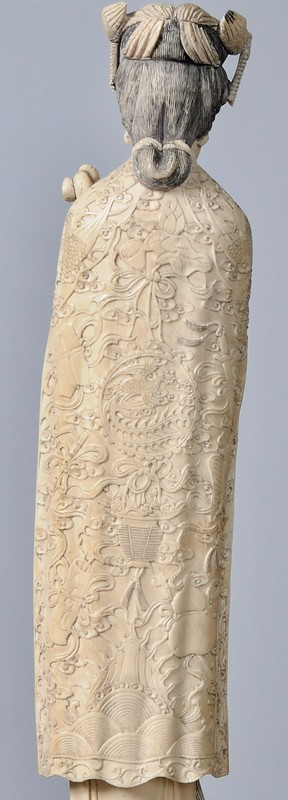
This emperor has a spike on his hat to connect him to the heavens.
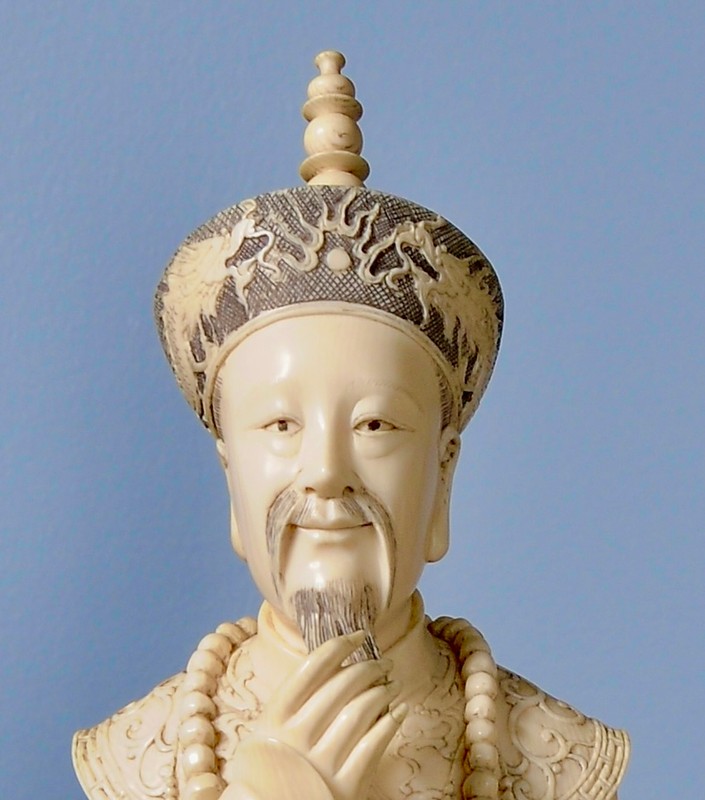
The empress holds a ruya, or scepter
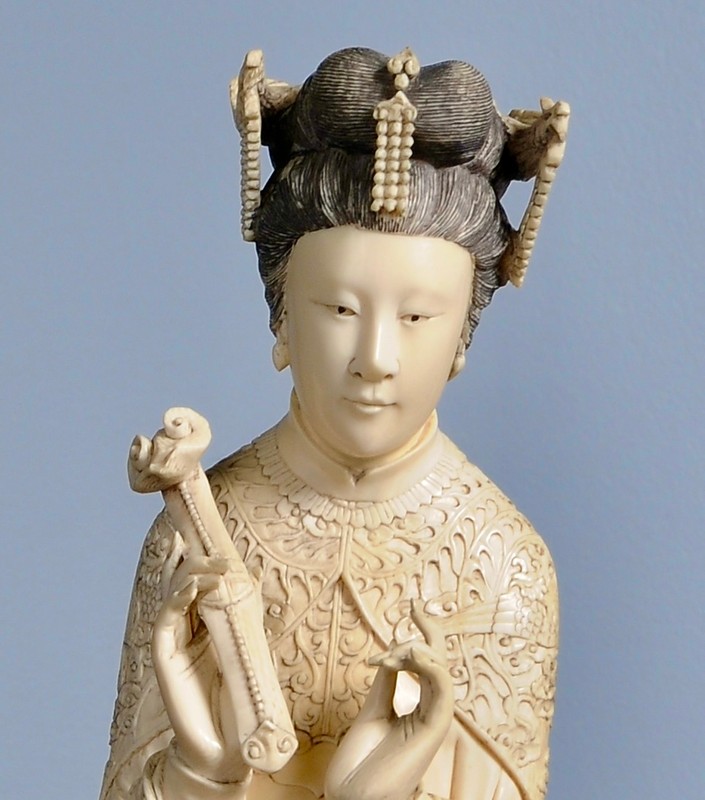
This carving shows the steps of society, from the peasants at the bottom, to the young child studying, and the scholar at the top.
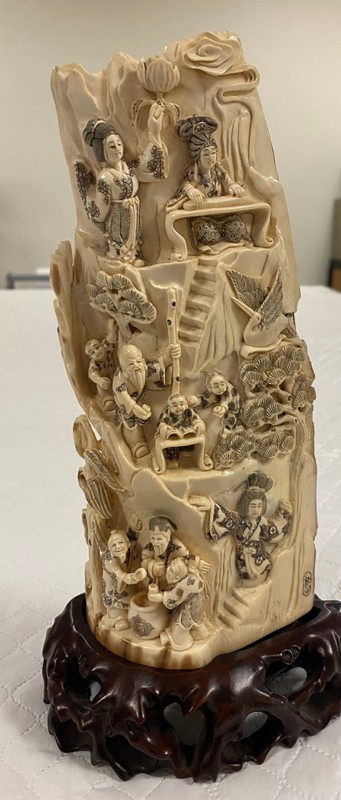
A necklace of beads carved from ivory.
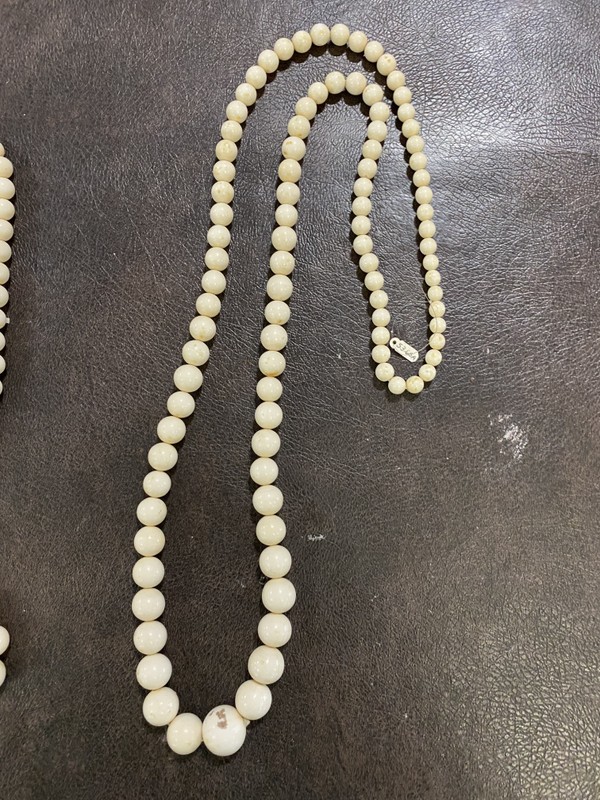
Lord Zhao Ding holds an ivory hu
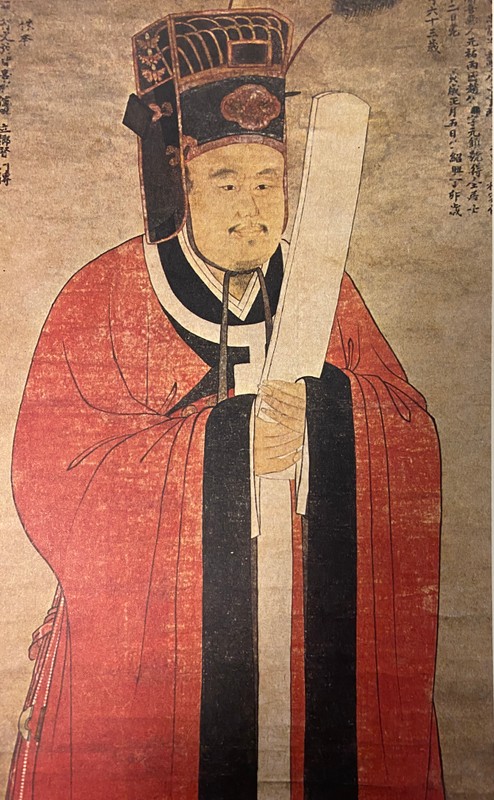
Backstory and Context
Text-to-speech Audio
First pair: Taller Chinese Emperor and Empress...
These tall, graceful figures are beautiful in their imposing height, the result of the large elephant tusks employed to make them. The carving is detailed both front and back. Their imperial dress is classic Qing dynasty and, as in all things Chinese, layers of meaning in the symbolism are woven into the garments...
The emperor is wearing a short jacket with medallions of five-clawed dragons, always the symbol of the Chinese emperor. This custom derives from the myth that the dragon is the lord of the heavens and the most important creature in Chinese mythology. Therefore, it is only suitable that the dragon be the symbol of the emperor, his counterpart on earth...
This emperor's hat happens to be missing the traditional spike on the top, visible on the other nearby carved emperor's hat. Traces of the missing spike are visible on the hat, so although clearly once there, the spike has been lost over time...
The empress is striking in her elaborate hairstyle and long embroidered cloak. Her hair is topped with a headdress featuring two cranes symbolizing longevity. Her gown is decorated with an important symbol, the mythological phoenix, traditionally used to represent the empress. The phoenix was the ruler of the birds in the same way that the dragon was the king of animals, thus making the phoenix an appropriate symbol for her. In addition, it symbolizes beauty, goodness, peace, and prosperity, considered attributes of a good empress...
The empress’ hairstyle, dating to the mid-Qing dynasty, was modeled on that of the Manchurian court women. The upper part was called the “high-rising coil." The end of the long tress of hair hanging down the back was trimmed into the shape of a tail and was called a “swallow's tail." This inimitable hairstyle can be seen in all its complexity in one of the photographs...
Second pair: Chinese Emperor and Empress Backed by a Mirror…
In almost all respects these two figures in the proscribed imperial court dress are identical to the first taller pair, with a few interesting details visible on the reverse sides in the mirror. Here, the tall spike on the top of the emperor’s hat is immediately evident. It is a very important symbol used to define the emperor’s role in China. It represents something like a “lightning rod” connection between the emperor and the mythological gods in heaven. From this connection comes his “mandate from heaven” to rule over the seas, the earth, and the heavens. As the story goes, if he performs his ceremonial duties well, all will go well in the country; if he does not, he alone is to blame. We also see his power symbolized on the hem of his garment, where the waves represent the seas, the central mountain represents the earth, and the dragons flying among the clouds represent the heavens. Why is he wearing a necklace? It is an imperial court necklace only worn by members of the imperial court on ceremonial occasions. The meanings of the attached shorter strands are curious. The two short strands of beads on his left shoulder symbolize the emperor’s father and father’s mother. On his right shoulder is a single strand representing the emperor’s mother...
Looking at his back in the mirror, you can see that the emperor wears his hair braided down his back. This is called a queue. It was a requirement for all Han Chinese men beginning in 1644 when China came under the Manchurian rule of the Qing dynasty. His queue is hiding a single strand of beads on the imperial court necklace. This loose strand was meant to swing back and forth as he walked to keep the evil spirits away...
The elegant empress is holding a ceremonial Ruyi scepter which in life would have been made of jade. It was the primary symbol of her wealth and importance as empress. The hem of her gown shows the emperor’s symbols of the seas, the earth, and the sky, as does all formal dress for members of the imperial court. Her outer cloak is especially magnificent in its carved details. She also wears a phoenix on the front of her gown, but on the back are carved the eight symbols of Taoism (also spelled Daoism.) Each one refers to the magical attributes of one of the Taoist Eight Immortals. Their appearance here reflects the veneration of the Ching court toward the ideals of Taoism...
Chinese Uses for Ivory...
One unique use of ivory was a tradition in imperial courts for many centuries. The hu, usually pictured as a long, narrow, curved, or flat, piece of ivory, sometimes carved on one side, was used to indicate the power of high court officials. It appeared around 250 BCE when it became fashionable for high court officials to carry memorandum tablets of ivory. First worn as hanging pendants from girdles, the ivory tablets eventually became longer over time and were carried almost as scepters. The tradition of using the hu to denote rank persisted until the fall of the Ming dynasty in 1644. You can see this illustrated in the photograph of an ancient prime minister painted holding a hu, like a scepter...
Over the centuries the Chinese found many luxurious uses for ivory: figures, brush holders, table screens, and snuff bottles. Artists made perfume boxes, and mirror cases for court ladies as well as utilitarian objects like chopsticks, Mah-Jong sets, combs, and seals. After the fall of the Ching dynasty in 1912, however, production switched from fulfilling imperial needs to making items like ivory canes and card cases for foreign residents and tourists. A flourishing market developed as the country progressed and, until outlawed, China was one of the world's largest markets for elephant ivory...
Elephant Ivory Today...
Many efforts have been made around the world to curb the slaughter of elephants for their tusks. In 1989 the Convention on International Trade in Endangered Species (CITES) classified the African elephant as an endangered species and banned the ivory trade. The numbers are alarming. The population of African elephants was 10 million in 1900, dropped to 1.3 million by 1979, and stood at 415,000 by 2015. Despite African conservation efforts, poaching remains a significant problem. The elephant population continues to decline, and in three countries the shrinkage rate of herds is faster than the replacement rate...
International reaction has been strong. Most countries have signed on to the CITES ivory trade agreement and are taking steps to enforce it through their own regulations. China has made all buying and selling of ivory and ivory products illegal. In the United States under Federal law, new ivory cannot be imported, exported, or sold across state lines. Antique ivory can be sold with proper documentation proving that the item is an antique that is at least 100 years old. The latest federal regulations for elephant and walrus ivory can be checked on the website of the US Fish & Wildlife Service...
Sources
Cox, Warren E.. Chinese Ivory Sculpture. New York, New York. Bonanza Books, a division of Crown Publishers, Inc., 1946.
Xun, Zhou . Chunming, Gao. 5000 Years of Chinese Costumes. San Francisco, California. China Books & Periodicals, Inc., 1987.
Smith, Bradley. Weng, Wan-go. China: A History in Art. Japan. Toppan Printing Co., Ltd. 1976.
"China's Ban on Ivory Trade Comes into Force." BBC News. January 1, 2018. Accessed September 14, 2023. https://www.bbc.com/news/world-asia-china-42532017.amp.
Ritchie, Hannah. "The State of the World's Elephant Populations." Our World in Data. December 1, 2022. Accessed September 14, 2023. https://ourworldindata.org/elephant-populations#:-text:=Elephant....
"Undercover Investigation Reveals Elephant Ivory Being Sold across Florida, and Sellers Who Do Not Have Papers to Prove Legality." The Humane Society of the United States. March 20, 2023. Accessed September 14, 2023. https://www.humanesociety.org/news/undercover-investigation-r...ls-elephant-ivory-being-sold-across-florida-and-sellers-who-do.
Phelan, Ben. "Overview of Current Ivory Law." PBS Antiques Roadshow. June 22, 2015. Accessed September 7, 2023. https://www.pbs.org/wgbbh/roadshow/stories/articles/2015/6/22ivory-law/.
Asian Art Collection 56.01-56.02
Asian Art Collection 56.01-56.02
Asian Art Collection 56.01-56.02
Asian Art Collection 56.01
Asian Art Collection 56.02
Pam Thames, Photographer
Asian Art Collection 56.03 - 56.04
Asian Art Collection 56.03 - 56.04
Asian Art Collection 56.03
Howard Collection 53.112
Asian Art Collection 56.04
Asian Art Collection 56.03
Asian Art Collection 56.04
Asian Art Collection 56.05
Howard Collection 53.61
China: A History in Art p. 192. Avery Brundage Collection
